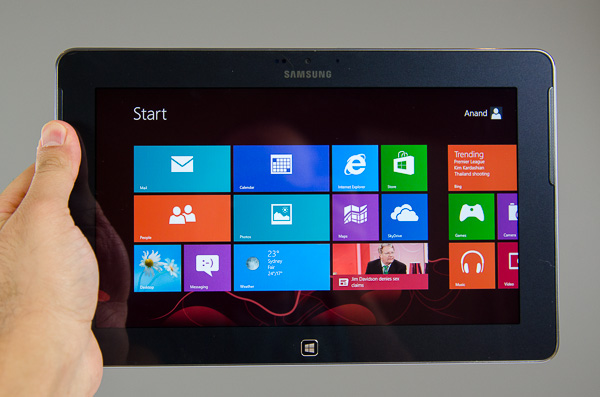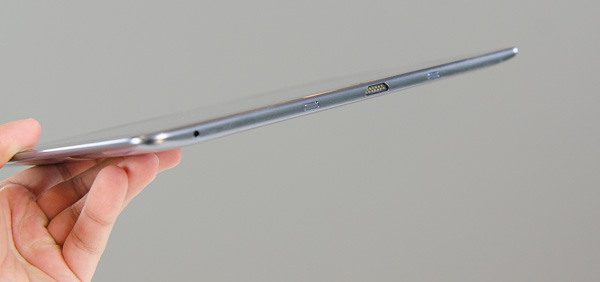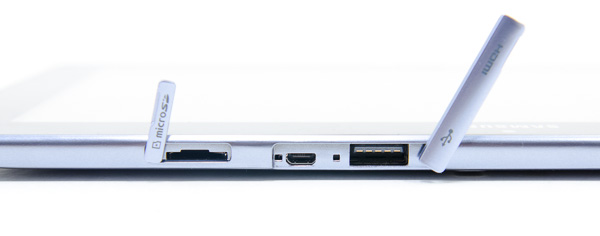Samsung ATIV Tab Review: Qualcomm's First Windows RT Tablet
by Anand Lal Shimpi on January 3, 2013 6:00 AM EST- Posted in
- Tablets
- Samsung
- Qualcomm
- Mobile
- Windows RT
I remember writing Intel and telling them that, from a tablet perspective, the Windows 8 launch might as well have been a Windows RT launch. By the time October 23rd rolled around, the only Windows tablets we had in for review were ARM based and running Windows RT. I even resorted to borrowing an unfinished Clover Trail tablet just so we’d have something to put Surface RT’s performance in perspective at launch.
Clover Trail was late by about a month to the Windows 8 launch. Most of the traditional PC partners were delayed either by Intel or by burdens of their own. As much as we wished Surface RT would’ve launched with a different SoC, truth be told I don’t know that anyone else outside of NVIDIA could’ve met the aggressive schedule that Microsoft set. Qualcomm and TI were both design partners working on Windows RT devices, but neither of them had solutions available at launch.
Now that we’re two months out from launch however, things are starting to change. We’ve already reviewed one of the first Clover Trail tablets, with another on the way. And just before the holidays last year, this thing showed up:
It may look like the Samsung ATIV Smart PC that Vivek is working on, but it’s the smaller 10.1-inch ATIV Tab featuring Qualcomm’s APQ8060A SoC. Yep, this is the first Windows RT tablet we have in house to use Qualcomm silicon.
In the phone space, Qualcomm’s Krait based SoCs have generally been the preferred platform. Using TSMC’s 28nm LP process, they’ve offered better power consumption than NVIDIA’s 40nm LPG Tegra 3. The 2 Krait cores housed in the more popular of these SoCs (MSM8960), at least in phones, generally delivered better performance than the NVIDIA alternative as well. But that was in the Android space - would things be any different on a Windows RT tablet? With an inherently more multitasking friendly device and OS, would NVIDIA’s quad-core approach trump Qualcomm’s pair-of-faster-cores? And what about battery life? Tegra 3 did remarkably well in Surface RT, but how would Qualcomm fare?
Armed with Samsung’s ATIV Tab, I tried to find out.
The Tab
As with most of Samsung’s tablet designs, the ATIV Tab is a tablet built out of plastic and glass. The design and feel aren’t bad, but they’re nothing particularly new or exciting. The big benefit of the plastic chassis is of course weight. The ATIV Tab weighs in at 572g compared to 688g for Surface RT, it’s around the same weight as the Acer W510 we reviewed a couple of weeks ago. The light weight means carrying it around is quite pleasant. And despite the plastic construction, build quality is solid. I noticed no creaks or unsettling flexibility in the chassis.
Internally there's a Qualcomm APQ8060A SoC (dual-core Krait running at up to 1.5GHz + Adreno 225, no integrated baseband) paired with 2GB of LPDDR2 memory. It is a bit surprising that Samsung/Qualcomm didn't opt to launch with APQ8064 (quad-core Krait), but I suspect this was a decision made more out of time to market than anything else.

On the storage side there's either a 32GB or 64GB eMMC solution soldered down on the board. Remember that Windows RT comes preinstalled with a full version of Office 2013 Home & Student Edition. After Samsung's preinstalled apps a 32GB ATIV Tab shows up with around 14.1GB of free space.
The ATIV Tab’s 10.1-inch 1366 x 768 display makes for a familiarly portable form factor. While the Smart PC’s 11.6-inch form factor makes for a better notebook, the ATIV Tab seems to be a better tablet.
Like the Clover Trail version, the ATIV Tab is littered with plastic doors over nearly every port around the perimeter of the device. Along the top the micro HDMI and full USB 2.0 port are behind a door, as is the microSD card slot. The doors do help maintain a smooth edge, but I’m not a fan of them.
Headphone jack, power/lock and volume up/down are also along the top of the tablet. There's no rotation lock button on the ATIV Tab. There's a physical Windows button on the front face of the tablet.
The sides are devoid of any intrusions into the ATIV Tab’s design, while the bottom edge features the charge port as well what looks like a dock connector. My review sample didn't come with a dock and Samsung's website doesn't seem to list any keyboard dock accessory for the ATIV Tab, so for now this port goes unused.
There are a pair of reasonably loud (for a tablet) stereo speakers that border the display, while front (1.9MP) and rear (5MP) cameras complete the package for Samsung.
| Tablet Specification Comparison | ||||||||
| Samsung ATIV Tab | Apple iPad 4 | Google Nexus 10 | Microsoft Surface RT | Samsung ATIV Smart PC | ||||
| Dimensions | 10.46 x 6.62 x 0.35" | 9.5 x 7.31 x 0.37" | 10.39 x 6.99 x 0.35" | 10.81 x 6.77 x 0.37" | 11.97 x 7.46 x 0.39" | |||
| Display | 10.1-inch 1366 x 768 IPS | 9.7-inch 2048 x 1536 IPS | 10.1-inch 2560 x 1600 PLS | 10.6-inch 1366 x 768 PLS | 11.6-inch 1366 x 768 PLS | |||
| Weight | 1.26 lbs | 1.44 lbs (WiFi) | 1.33 lbs | 1.5 lbs | 1.64 lbs | |||
| Processor | Qualcomm APQ8060A (2 x 1.5GHz Krait, Adreno 225) |
Apple A6X (2 x Swift, PowerVR SGX 554MP4) |
Samsung Exynos 5 Dual |
NVIDIA Tegra 3 |
Intel Atom Z2760 (2 x 1.8GHz Atom, PowerVR SGX 545) | |||
| Connectivity | WiFi | WiFi , Optional 4G LTE | WiFi | WiFi | WiFi , Optional 4G LTE | |||
| Memory | 2GB | 1GB | 2GB | 2GB | 2GB | |||
| Storage | 32-64GB | 16GB—64GB | 16GB or 32GB | 32GB or 64GB | 64GB | |||
| Battery | 30.0Wh | 42.5Wh | 33.75Wh | 31.5Wh | 30.0Wh | |||
| Starting Price | $499? | $499 | $399 | $499 | $599 | |||
The more I use other Windows RT/8 tablets, the more I'm realizing that the stability issues I encountered with Acer's W510 are more a function of that tablet and less a general Microsoft problem. Although I did experience a couple of unexpected app crashes, the overall experience with Samsung's ATIV Tab was positive. I didn't see anywhere near the number of cases of strange behavior as I did with the W510. I'm beginning to wonder if Clover Trail's Windows 8 software stack isn't as mature as the Windows RT implementations that I've played with.














42 Comments
View All Comments
snoozemode - Thursday, January 3, 2013 - link
Lets hope that is the case. But if that is what Blue is, what about current Windows RT devices? And WP8 devices? Will they too be left in the cold as WP7.5 devices? For me it feels like Microsoft has created this massive pile of mess that I'm not sure how long it will take before it's sorted out. I mean my Windows 8 computer still has two separated Internet explorers that doesn't sync favorites between eachother, and this is in year 2013.Silent_Rage - Thursday, January 3, 2013 - link
The current RT and WP8 devices will be upgraded to Blue as well. I'm positive of this since Blue is a smaller form of an update as compared to the usual cycle we've seen with Windows in the past. Windows Blue will be the first "annual" update to Windows and we will see granular changes to Windows RT. On the backend, we will see a shift to align the two OSs (RT and WP8) to share the same APIs, more so than what we're seeing today.ninjacut - Thursday, January 3, 2013 - link
I actually prefer Microsoft approach of not using Phone OS on a tablet, firstly it simply becomes a more productive device and can handle content creation activity better than the Phone OS. Secondly, the way performance is improving in these SOC's the Phone OS will need to catch-up in features. This is already happening with Android doing multi-user and split screen like WRT and will continue to do so. Microsoft has a good advantage at this point.Regarding the 7inch form factor, WRT can perform well but certain features will make less sense such as the desktop. But its again advantage and not a disadvantage.
The challenge is to release WRT 7inch tablet, at the right price asap!
snoozemode - Friday, January 4, 2013 - link
My point is that the WRT UI could stay as it is, the OS would just change UI depending on screen size as Android did in ICS.Regarding desktop in WRT, can't really see the point of having it since you can't run any legacy programs anyway. It's basically there to run Office 2013. Make a Metro UI Office and remove Desktop.
Wolfpup - Thursday, January 3, 2013 - link
This sounds like a dumb question, but do Windows Phone 8 programs also run on Windows 8 and RT? P8 runs P7 stuff, and I've been assuming that RT and real Windows 8 can run Windows Phone 7 and 8 programs too, but not necessarily optimized for the display, iOS style...but I actually have no idea if that's the case.Also...I have no idea if it's even possible to back up metro programs. I'm not a huge fan of iOS, but one of the things it does right is let you back up programs to a PC, so you can manage them and don't have to redownload multiple GB onto a new device, or when you're juggling storage.
Really disapointed Metro isn't open though...otherwise Windows 8 is what I've wanted since before the original iPad-a real PC that has an optional tablet interface...but to be a real PC it has to be OPEN...ironically Android is open (technically), Windows 8 as a desktop OS is open, but metro isn't :(
damianrobertjones - Thursday, January 3, 2013 - link
1080p 'real' resolution on a device like this would feature text so small you wouldn't be able to read. Increase the DPI? Might as well just drop straight to 1366x768.Marketing.
DeciusStrabo - Friday, January 4, 2013 - link
Like Android Windows 8 is able to display Metro-Apps independently from the physical resolution, meaning they always use a logical resolution (which makes them look like Babbies first computer-Apps on my 27" screen, since all elements and letters are huge, not taking advantage of the space offered, simply making everything scale up.However the advantage is of course that this way they can use more pixels to display elements, making them look smoother (what Apple does with Retina, but more flexible as you aren't limited to multiples of their logical resolutions and the weird and resources intense offscreen rendering process).
So 1080p would be great to have on Windows RT/WP8 devices too, as it just means smoother and more readable UI elements, not smaller UI elements (disadvantage on desktops, advantage on mobile devices).
mayankleoboy1 - Thursday, January 3, 2013 - link
It has Adreno225.How about NOOOO
killerclick - Thursday, January 3, 2013 - link
Lol @ 1366x768Lol @ dead platform
Lol @ available storage
It's worth $350 at most (not even that if you don't need Office), although seeing how Metro devices are doing, they should be offering more for less.
BrokenCrayons - Thursday, January 3, 2013 - link
I'm not at all a huge fan of Windows RT devices since I just don't see the value added in limiting one's computing to a keyboard-less device or having to add a keyboard at additional cost to perform data entry at a reasonable speed, but tablets have their place as content consumption and entertainment devices. They're also the current wizbang thing to purchase, replacing other fads like 3D TV and netbooks.All that said, there's really nothing wrong with the screen's resolution given the 10 inch size. Yes, there's lots higher resolution devices available, but to make those devices usable, objects on screen must be scaled to a reasonable size, negating lots of the advantages while costing in battery life and platform performance managing pixels that are simply there to be checkbox specification for marketing.
The platform isn't dead yet. It might go the way of Windows Mobile someday, but it's sort of early to assume such is the case.
The device storage is pretty disappointing. Sure you can add memory via SD or an external devices, but it would be nice to be able to use more of what you're paying for OR for the cost of additional storage to be lower. One of the things that I don't care much for with RT (and 8-based tablets as well) is the large footprint of the OS. It hasn't gotten much worse since 7's launch, but the move from rotating hard disks to flash memory has certainly made getting lots of storage an expensive prospect. Power consumption and durability are nice, but vendors do make you pay if you want to keep much information on the device itself.